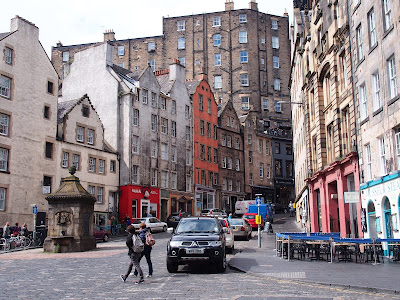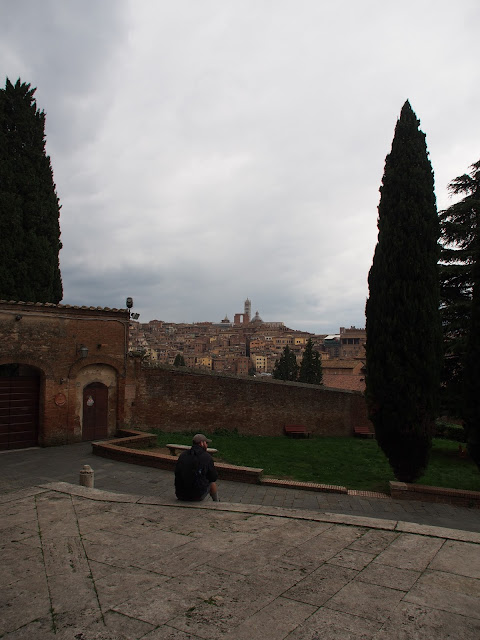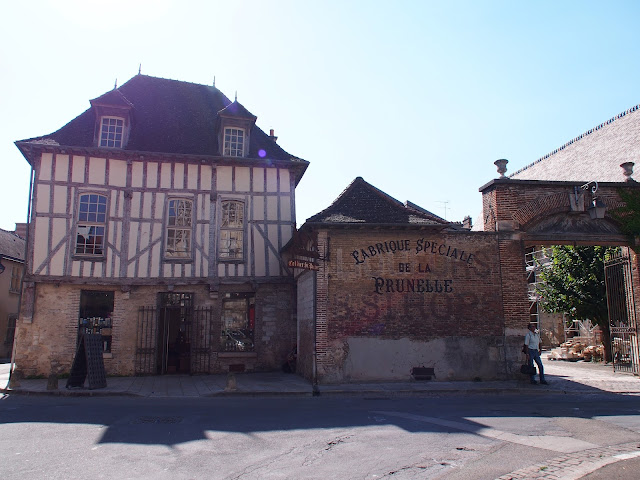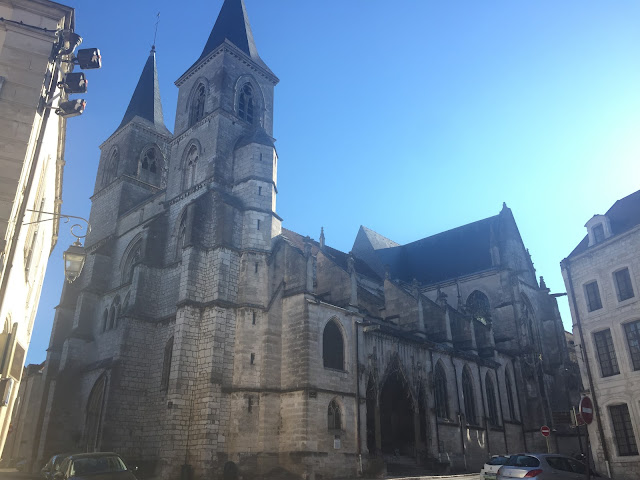7/15-18
I arrived in Canterbury on Friday afternoon. I had emailed the Franciscan International Study Center to see if they could put me up for a few days and once I found it a few miles out of town, Friar Thomas generously showed me the dorm I would be using. I was able to unpack all my things and let everything dry from the rain up in Scotland. It was very nice having a room to myself for the first time and not sharing it with 8-20 other people!
 |
| West Gate into the old town |
Canterbury is a quintessential small medieval town, filled with wooden framed whitewashed wattle and daub houses.
 |
| Gorgeous flowers on the river walk |
|
I noticed that many of the stone buildings were finished with flint. This makes for an interesting and almost jewel-like effect on the walls particularly up close. When I visited the Eastbridge Hospital, a curator told me that the beaches in southern Britain are very rich in flint and so it was a primary building material in many of the stone buildings.

The Eastbridge Hospital was a fascinating place to visit, especially as a pilgrim. It had been founded in the years following Archbishop Thomas Becket's death as a place of accommodation for the rising pilgrim numbers coming to visit his shrine in Canterbury Cathedral. Thomas Becket had risen from a merchant's son to the Archbishop of Canterbury in the early 12th century. Throughout his career, he had thwarted and angered King Henry II so much that in a fit of rage Henry is famed to have said: "Who will rid me of this troublesome priest?" To which four of his more zealous knights assassinated Thomas Beckett as he was praying in Canterbury Cathedral in 1170. Thomas quickly became a saint, and Canterbury Cathedral became a popular pilgrim destination. The Eastbridge Hospital was built in 1176 and catered to the rising pilgrimage trend until King Henry VIII split from the Church of Rome and had many religious institutions surrender their wealth and land to the government. Thomas Becket's shrine was destroyed, and the pilgrimage tradition declined. The hospital then was used as accommodation for poor people and as a shelter and care house to soldiers passing through.
 |
| Eastgate Hospital, you can see how short the door is from the rising street level |
You can see from the inside looking out at the road how high the ground level has risen since medieval times. The undercroft at the bottom of the stairs would have been at street level.
This chapel had been built in 1180 and was part of the original building.

During renovations this wooden beam was added for support and supposedly came from a medieval inn called The Saracen's Head!
 |
| Wooden beam under lights |
The undercroft would have been used as the pilgrims sleeping area. On one side there are divided walls where two pilgrims would have slept at a time. You can see some of the arches are warped. This is from the shifting foundations of the building due to the movement of the river Stour throughout the ages. The hospital sits right next to the river.
 |
| The pilgrim's "rooms" |
The refectory would have been used as the pilgrims' meal hall. On the north wall, there is an early 13th-century mural still intact.
Lastly, we had the pilgrims chapel which was built a little later. The gorgeous wooden ceiling is from 1285! Several buildings in Canterbury used wooden ship hulls for their roofs.
Next, I visited the ruins of the Canterbury castle which was built soon after the Norman invasion in 1066 by William the Conqueror. For most of its history it was used as a prison rather than a residence. Like most Norman castles the only door into the building was on the second level, so the only way to enter was with a removable stairway on the outside.
 |
| Entrance to the keep |
 |
| Inside you can see where the first floor was |
 |
| Cool stairwell |
You can see the foundations of a gatehouse that was added after the castle became a prison.
 |
| Gatehouse with some bored youth behind |
I followed the Medieval and Roman walls to Dane John park.
This was a delightful urban park with a very cool history. In Roman times they built a large burial mound in the center of the green. After the Romans left England the mound was used as a small hill fort. During the Norman invasion, William the Conqueror initially put his fort on the mound while his castle was built a little ways away. After medieval times it was used as grazing land for livestock and eventually became the community park. School had just ended, and the park was filled with lively youngsters, and someone had filled the fountain with dish soap resulting in a spray of foam!
The name Dane John comes from a bastardization of the Norman word "donjon," meaning castle. A little fun fact for non-history nerds, dungeon also comes from the Norman "donjon."
 |
| A very cool kids play area |
Afterward, I meandered around for a bit just exploring. I happened upon the most photogenic slump of a medieval building turned bookstore... Literally all my favorite things in one!
 |
| Charles Dickens seemed to have appreciated its beauty |
On Sunday I walked to Canterbury Cathedral. Next to the entrance is the Cathedral Gate Hotel, one of the main accommodations for pilgrims since it opened.
With my pilgrims' credentials, I was able to get in free and also received my first official stamp!! I walked around and saw the kilometer zero stone of the Via Francigena! This is where I will start my pilgrimage from on Monday.
I explored around the cathedral then popped into the nave. Sunday service was in progress, but they allow visitors to sit and watch. Although I'm not religious, I very much enjoyed listening to the fantastic choir. They literally had voices like angels, and the nave of the cathedral made the music loud, vibrant and powerful.
 |
| Canterbury Cathedral |
 |
| Cloisters |
 |
| I love seeing old steps worn away by humanity and the passage of time |
 |
| 12th century frescoes in the crypt |
 |
| Romanesque captial in the crypt |
 After the service, I walked around the cathedral. I found the chapel where Thomas Becket had been assassinated. Also, I found out that King Henry IV and Edward the Black Prince of Wales are buried here. I hadn't known that before.
After the service, I walked around the cathedral. I found the chapel where Thomas Becket had been assassinated. Also, I found out that King Henry IV and Edward the Black Prince of Wales are buried here. I hadn't known that before.
 |
| Where Thomas Becket was murdered |
 |
| The library and information center in a 19th-century building |
I have now returned to my room in the Franciscan study center to do laundry and pack before the start of my pilgrimage.
I will update you all soon!
Buen Camino!


 The Eastbridge Hospital was a fascinating place to visit, especially as a pilgrim. It had been founded in the years following Archbishop Thomas Becket's death as a place of accommodation for the rising pilgrim numbers coming to visit his shrine in Canterbury Cathedral. Thomas Becket had risen from a merchant's son to the Archbishop of Canterbury in the early 12th century. Throughout his career, he had thwarted and angered King Henry II so much that in a fit of rage Henry is famed to have said: "Who will rid me of this troublesome priest?" To which four of his more zealous knights assassinated Thomas Beckett as he was praying in Canterbury Cathedral in 1170. Thomas quickly became a saint, and Canterbury Cathedral became a popular pilgrim destination. The Eastbridge Hospital was built in 1176 and catered to the rising pilgrimage trend until King Henry VIII split from the Church of Rome and had many religious institutions surrender their wealth and land to the government. Thomas Becket's shrine was destroyed, and the pilgrimage tradition declined. The hospital then was used as accommodation for poor people and as a shelter and care house to soldiers passing through.
The Eastbridge Hospital was a fascinating place to visit, especially as a pilgrim. It had been founded in the years following Archbishop Thomas Becket's death as a place of accommodation for the rising pilgrim numbers coming to visit his shrine in Canterbury Cathedral. Thomas Becket had risen from a merchant's son to the Archbishop of Canterbury in the early 12th century. Throughout his career, he had thwarted and angered King Henry II so much that in a fit of rage Henry is famed to have said: "Who will rid me of this troublesome priest?" To which four of his more zealous knights assassinated Thomas Beckett as he was praying in Canterbury Cathedral in 1170. Thomas quickly became a saint, and Canterbury Cathedral became a popular pilgrim destination. The Eastbridge Hospital was built in 1176 and catered to the rising pilgrimage trend until King Henry VIII split from the Church of Rome and had many religious institutions surrender their wealth and land to the government. Thomas Becket's shrine was destroyed, and the pilgrimage tradition declined. The hospital then was used as accommodation for poor people and as a shelter and care house to soldiers passing through.























































So glad you have finally been able to start updating your blogs!! Love the photos and history. Canterbury is certainly rich on both fronts!! I agree, the bookstore is quite impressive...
ReplyDelete